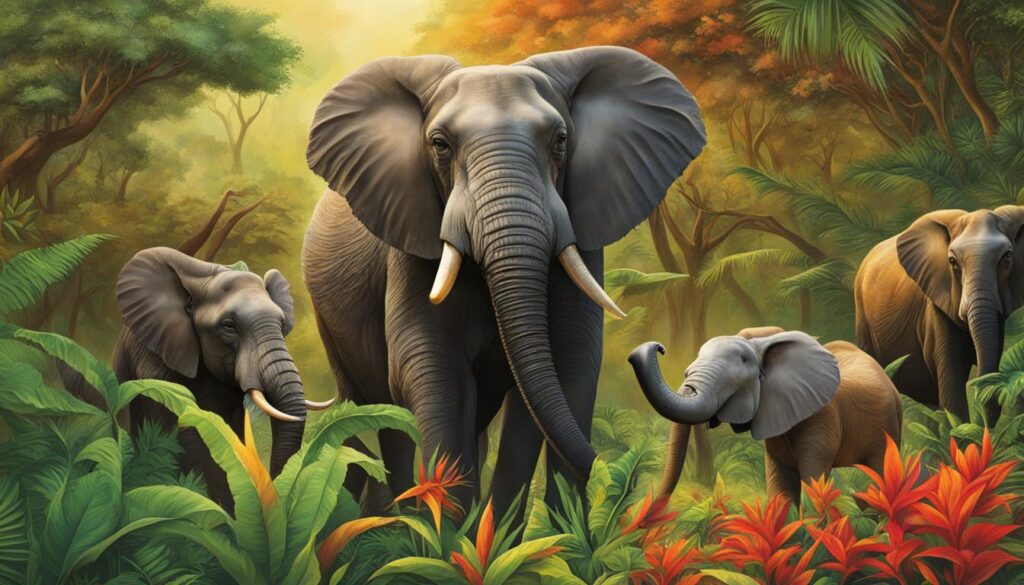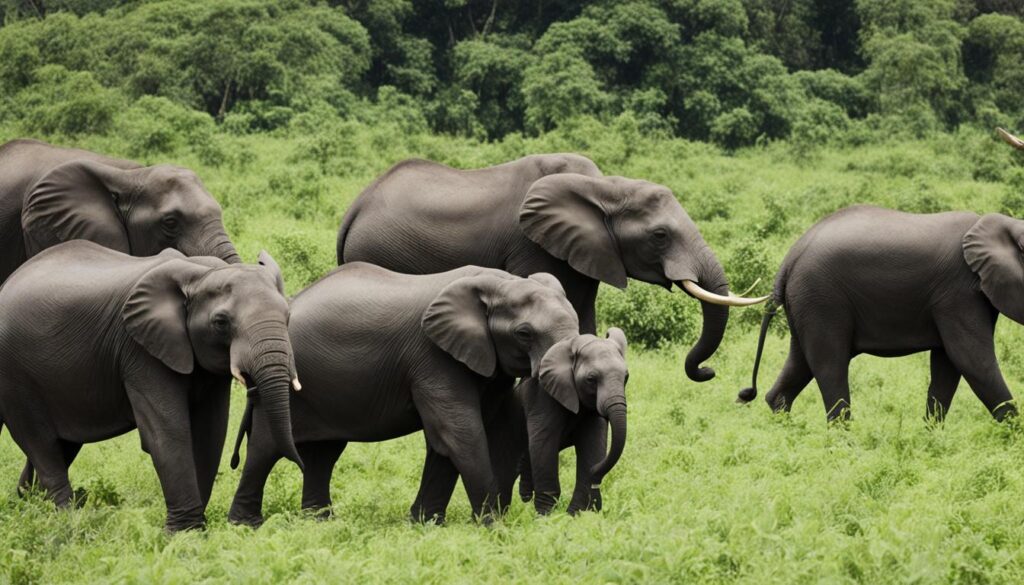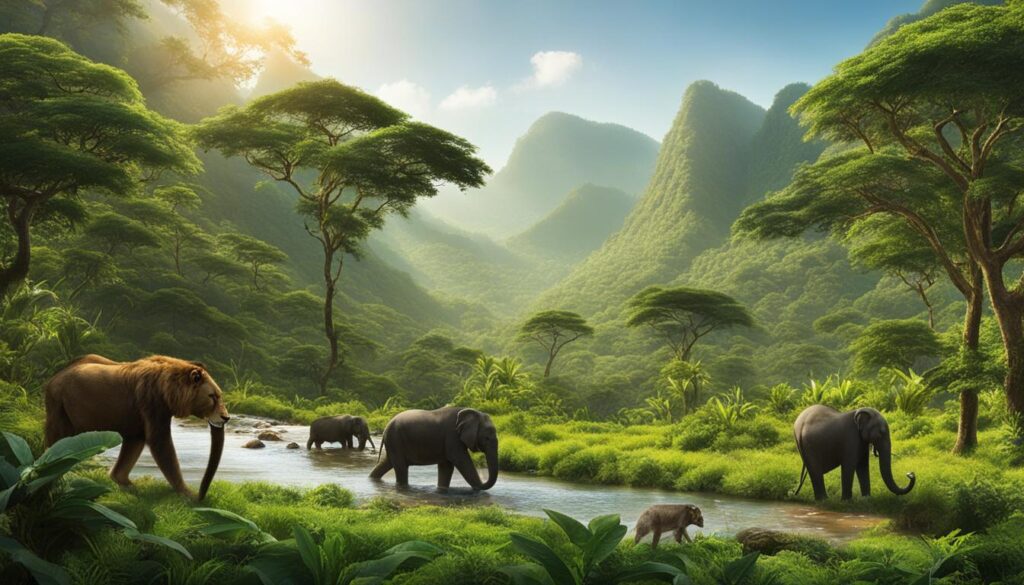Ghana is a country renowned for its incredible wildlife and diverse ecosystems. From the lush forests to the vast savannas, Ghana is home to a rich array of animal species, making it a haven for wildlife enthusiasts and nature lovers alike.
The fauna of Ghana is characterized by a remarkable variety of mammals, reptiles, birds, and marine life. Endangered species also find sanctuary within the borders of Ghana, as the country has placed a strong emphasis on wildlife conservation and the protection of animal habitats.

Key Takeaways:
- Ghana boasts a diverse range of animal species, including mammals, reptiles, birds, and marine life.
- Endangered species are protected through wildlife conservation efforts in Ghana.
- The country’s national parks and reserves play a crucial role in preserving animal habitats.
- Ghana offers unique opportunities for observing and experiencing wildlife in various ecosystems.
- Conservation efforts in Ghana contribute to the preservation of Ghanaian wildlife for future generations.
Vegetation in Ghana
Ghana’s vegetation is characterized by three main types: the coastal savanna, the forest zone, and the northern savanna. Each of these regions has unique features and adaptations that make it distinct.
Coastal Savanna
The coastal savanna is located in the southeastern plains around Accra. This region is known for its scrub and tall grass vegetation, with notable features such as giant anthills and drought-resistant plants. The coastal savanna is an important ecosystem supporting a variety of wildlife.
Forest Zone
The forest zone covers the southern third of the country, including areas along the Akwapim-Togo Ranges. It is characterized by evergreen and tropical semi-deciduous forests, rich in biodiversity. These forests provide habitats for numerous plant and animal species, contributing to Ghana’s ecological balance.
Northern Savanna
The northern savanna is found in the northern two-thirds of Ghana. This region features tall Guinea grass and scattered low trees, adapted to the low annual precipitation and intense drought experienced in the area. The vegetation in the northern savanna supports wildlife species that are specifically adapted to these harsh conditions.
“Ghana’s vegetation is diverse and ecologically significant, ranging from the coastal savanna to the lush forests and the arid northern savanna. Each region is home to unique plants and animals, showcasing the country’s rich natural heritage.” – Ghanaian ecologist
The forest zone in Ghana has faced significant challenges over the years, including deforestation due to farming practices and timber exploitation. To combat these issues and protect the forests, various forest conservation and reforestation efforts have been implemented in Ghana.
Conservation initiatives aim to restore and preserve the forest zone, safeguarding the diverse flora and fauna that depend on it. Reforestation projects have also been instrumental in restoring degraded forest areas and creating sustainable habitats for wildlife.
The vegetation in Ghana is not only vital for the country’s ecology but also contributes to the well-being and livelihoods of local communities. The forests provide timber resources, non-timber forest products, and play a crucial role in maintaining water cycles and regulating climate patterns.
By prioritizing forest conservation and reforestation efforts, Ghana is taking important steps to sustain its unique and diverse vegetation for future generations to enjoy.
Animal Diversity in Ghana
Ghana is renowned for its remarkable animal diversity, encompassing a wide range of fascinating species. From majestic lions to elusive leopards, the country boasts a rich collection of mammals. Other notable mammals found in Ghana include hyenas, elephants, buffaloes, chimpanzees, monkeys, snakes, crocodiles, hippos, lizards, and tortoises. These diverse mammals contribute to the ecosystem’s stability and provide unique opportunities for wildlife enthusiasts.
Birdwatchers will revel in the abundance of avian species found in Ghana. Parrots, hornbills, eagles, and numerous other bird species grace the skies and enchant nature enthusiasts with their vibrant colors and melodic songs.
The waters surrounding Ghana are teeming with marine life. Various species of fish, sea turtles, and amphibians thrive in the ocean, rivers, and inland lakes, creating sensational opportunities for diving and exploration. The underwater world of Ghana showcases the beauty and diversity of marine ecosystems, contributing to the nation’s rich biodiversity.
The insect life in Ghana is equally captivating, boasting a wide array of beetles, fireflies, ants, butterflies, and mosquitoes. These insects play essential roles in pollination, decomposition, and nutrient cycling, maintaining the delicate balance of the ecosystem.
“Ghana’s animal diversity is a testament to the country’s commitment to preserving its natural heritage. Exploring the remarkable variety of mammals, birds, marine life, and insects offers a unique and immersive experience for nature lovers and provides a deeper understanding of the interconnectedness of all living beings.”
List of Endangered Species in Ghana
| Category | Example Species |
|---|---|
| Mammals | African white-bellied pangolin, olive colobus, sooty mangabey, African forest elephant |
| Birds | Yellow-headed picathartes, white-necked picathartes, Grey Parrot, black-casqued hornbill |
| Reptiles | Pacific leatherback turtle, African slender-snouted crocodile, Nile crocodile, African rock python |
| Amphibians | Ghana live frog, giant West African tree frog, Togo slippery frog, African clawed frog |
The presence of endangered species in Ghana necessitates conservation efforts. Wildlife conservation initiatives, coupled with the establishment of national parks and reserves, aim to protect these vulnerable species and their habitats. By raising awareness and implementing sustainable practices, Ghana strives to preserve its animal diversity for future generations to appreciate and learn from.
Endangered Species in Ghana
Ghana is home to several endangered species, facing significant threats to their survival due to habitat loss, poaching, and the wildlife trade. The conservation status of these species highlights the urgent need for wildlife conservation efforts in Ghana.
Among the endangered mammals in Ghana are the African white-bellied pangolin, olive colobus, sooty mangabey, and African forest elephants. These iconic species are at risk due to illegal hunting and loss of their natural habitats.
Ghana’s efforts to protect and conserve these endangered animals are implemented through wildlife conservation initiatives, reforestation projects, and the establishment of national parks and reserves.
By raising awareness about the importance of preserving Ghana’s biodiversity and implementing effective conservation strategies, we can safeguard these threatened species for future generations.

The image above depicts the delicate balance between Ghana’s wildlife and the challenges they face.
| Endangered Species | Conservation Status |
|---|---|
| African White-Bellied Pangolin | Endangered |
| Olive Colobus | Endangered |
| Sooty Mangabey | Critically Endangered |
| African Forest Elephants | Vulnerable |
The table highlights some of the endangered mammals in Ghana and their conservation statuses.
National Parks and Reserves in Ghana
Ghana is blessed with several national parks and reserves, serving as invaluable sanctuaries for diverse wildlife and playing a vital role in their conservation efforts. These protected areas not only provide a safe haven for numerous species but also offer incredible opportunities for visitors to experience the beauty of Ghana’s natural heritage. Let’s explore some of the prominent national parks and reserves in the country:
Mole National Park
Mole National Park is the largest and oldest game viewing park in Ghana, located in the northern region. Spanning over 4,577 square kilometers, this park boasts an impressive array of wildlife, including elephants, buffaloes, lions, and various antelope species.
Kakum National Park
Kakum National Park is renowned for its lush rainforest and thrilling canopy walkway, offering visitors a unique and immersive experience in the heart of nature. Explore the dense vegetation and keep an eye out for monkeys, duikers, and a wide variety of bird species.
Bui National Park
Bui National Park, situated along the scenic Black Volta River, is a haven for hippos, antelope, and leopards. This park covers an area of approximately 1,821 square kilometers and provides an opportunity to witness the captivating wildlife of Ghana.
Other Reserves
In addition to the prominent national parks mentioned above, Ghana is home to several other reserves that offer unique biodiversity and habitats for a wide range of species. Nini Suhien National Park and Ankasa Resources Reserve provide a safe environment for elephants, monkeys, and a diverse array of bird species.
Explore the wonders of these national parks and reserves in Ghana, where breathtaking landscapes and unforgettable encounters with wildlife await.

Dangerous Animals in Ghana
Ghana is renowned for its incredible wildlife diversity, but it’s important to note that some animals pose potential dangers. Whether you’re exploring the national parks or venturing into the wilderness, here are some key species you should be aware of:
Hippos
Hippos, known for their enormous size and unpredictable behavior, can be dangerous to humans. Although they may seem docile, it’s crucial to keep a safe distance to avoid any potential harm.
Mosquitoes
While small in size, mosquitoes in Ghana carry the risk of transmitting diseases like malaria. Protective measures, such as using insect repellents and wearing long sleeves, can help minimize the risk of mosquito-borne illnesses.
Elephants
Elephants are magnificent creatures, but when they feel threatened or cornered, they can become dangerous. It’s important to respect their space and avoid any actions that may provoke them.
Black Mamba
The black mamba, a venomous snake found in Ghana, is one of the most dangerous reptiles in the country. Its powerful venom can be lethal, so it’s best to maintain a safe distance from these snakes and seek immediate medical attention in the case of a bite.
Lions
While the number of lions in Ghana is relatively small, there have been reports of lion attacks on humans. If you encounter a lion, it’s essential to remain calm, avoid sudden movements, and slowly back away without turning your back on the animal.
| Animal | Danger Level |
|---|---|
| Hippos | High |
| Mosquitoes | Medium |
| Elephants | Medium |
| Black Mamba | High |
| Lions | Medium |
It’s important to remember that these animals should be appreciated and respected from a safe distance. Being aware of these potential dangers and taking necessary precautions will ensure a safe and enjoyable wildlife experience in Ghana.
Conclusion
Ghana offers an incredible diversity of animals, from the majestic lions and elephants to the unique bird species and fascinating insects. The country’s national parks and wildlife reserves are crucial for protecting and conserving these remarkable animals and their habitats.
While exploring the wildlife in Ghana, it is essential to be aware of the potential risks posed by dangerous animals and to take necessary precautions. Hippos, elephants, mosquitoes, and the venomous black mamba snake can all present dangers to human safety. By being mindful of these potential risks and following safety guidelines, visitors can enjoy an enriching and safe wildlife experience in Ghana.
By appreciating and respecting the rich fauna of Ghana, we can contribute to its conservation efforts and ensure the survival of these incredible species for future generations. Supporting the national parks, wildlife reserves, and conservation initiatives in Ghana is crucial in maintaining the delicate balance of the ecosystem and protecting endangered species.
Let us continue to cherish and preserve the remarkable wildlife in Ghana, promoting sustainable tourism and conservation practices to ensure the long-term survival of these remarkable animals and the rich biodiversity that makes Ghana such a unique and special destination.
FAQ
What kind of animals can I find in Ghana?
Ghana is home to diverse wildlife, including mammals like lions, leopards, elephants, buffaloes, and chimpanzees. There are also various species of monkeys, snakes, crocodiles, hippos, lizards, and tortoises. Ghana is a birdwatcher’s paradise, with parrots, hornbills, and eagles among the many bird species you can spot. The ocean and inland lakes support a thriving marine life as well.
What are the different types of vegetation in Ghana?
Ghana’s vegetation can be classified into three main types. The coastal savanna consists of scrub and tall grass, while the forest zone is characterized by evergreen and tropical semi-deciduous forests. The northern savanna features tall Guinea grass and scattered low trees.
Which are the endangered species in Ghana?
Ghana is home to endangered species such as the African white-bellied pangolin, olive colobus, sooty mangabey, and African forest elephants. Many bird species, reptiles, and amphibians are also at risk.
What are some of the national parks and reserves in Ghana?
Ghana has several national parks and reserves, including Mole National Park, Kakum National Park, and Bui National Park. These protected areas provide important habitats for wildlife and contribute to their conservation efforts.
Are there any dangerous animals in Ghana?
Yes, there are dangerous animals in Ghana. Hippos, elephants, and the black mamba snake can pose threats to human safety. Mosquitoes are also dangerous due to the transmission of diseases like malaria. While lion attacks are rare, there have been reports of such incidents in Ghana.
